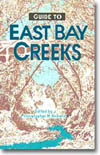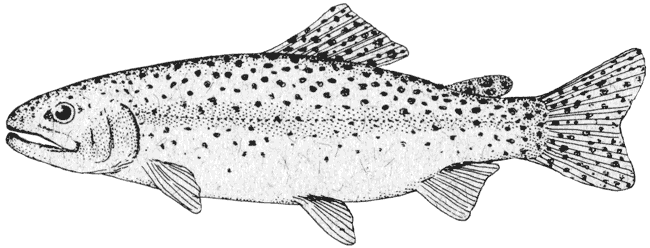GUIDE TO EAST BAY CREEKS
Chapter Six
Local Fish Makes Good
 Trout, steelhead, and salmon, once the dominant fish of our streams, now live mostly in our dreams. But who they were and what we know of them remains as surprising and puzzling as ever. The ongoing controversy over their names is illustrative. It may seem like much ado about nothing — names come and go, the fish remain — but just like your name, a species name represents genealogy. As our understanding of a species' evolution changes, the name changes to mirror that understanding.
Trout, steelhead, and salmon, once the dominant fish of our streams, now live mostly in our dreams. But who they were and what we know of them remains as surprising and puzzling as ever. The ongoing controversy over their names is illustrative. It may seem like much ado about nothing — names come and go, the fish remain — but just like your name, a species name represents genealogy. As our understanding of a species' evolution changes, the name changes to mirror that understanding.
The true salmon of our East Bay creeks were coho salmon (Oncorhynchus kisutch), but most people call them silver salmon. They were probably the first to disappear, as they would spawn lower in the creeks, where human impact was felt most.
Most people think they know what a rainbow trout (Oncorhynchus mykiss) is; most biologists are not so sure. One complication is that some of this species live full-time in streams and lakes, fulfilling our expectations of trout. But others, called steelhead, swim to sea at fingerling size, spend three years there, and swim back to their streams of birth to spawn. This anadromous life cycle is what most people associate with salmon. However, these anadromous steelhead are the same species as rainbow trout.

In another complication, this species includes two evolutionary stages. The more primitive fish, called redband trout, are found farther inland, east of the Cascade Mountains, and in California above migration barriers such as waterfalls. The more advanced coastal rainbow trout occur in the coastal drainages of the entire northern Pacific from Russia to Mexico, including most of the Sacramento-San Joaquin River system. Both the redbands and coastal rainbows include anadromous fish (steelhead) and stream-resident trout.
At this point, the story of how these fish got their names turns interestingly local. In 1855, Dr. H. Gibbons of the California Academy of Natural Sciences (popularly called Steinhart Aquarium) described a new trout species, Salmo iridia, based on some five-inch fish caught in San Leandro Creek. This became the official description of rainbow trout, which were assumed to live in streams.
In 1879, Lake Chabot was built, and the upper San Leandro watershed was closed off to protect the East Bay water supply. Through this happy accident you can see a population of these fish, undiluted by hatchery trout, in Redwood Park. They are also used to restock other East Bay streams.
In 1836, John Richardson named an anadromous fish Salmo Gairdnerii. In time, these fish were commonly called steelhead and eventually recognized to be the same species as rainbow trout. But, two subspecies were recognized; the steelhead were renamed Salmo gairdneri subspecies gairdneri, and the stream-dwelling trout were named Salmo gairdneri irideus.
Between the 1960s and the 1980s, biologists recognized that the fish could switch between the two life-history patterns, so the subspecies distinction was dropped.
Biologists also realized that our Pacific Rim trouts were closer to the Pacific salmon than to the Atlantic Rim trouts. Thus, in 1990 rainbow trout and steelhead were renamed Oncorhynchus mykiss.
There is yet another twist. People realized recently that our San Leandro Creek fish, the ones Gibbons named Salmo iridia, were young steelhead, and suspect the fish Richardson named Salmo Gairdnerii was actually an anadromous redband. So now, the old names may reemerge; but the fish they would be given to have flip flopped somewhat. Oncorhynchus mykiss gairdneri would be the redband trout (at least some of them), and Oncorhynchus mykiss irideus would refer to the steelhead and coastal rainbow trout.
Do the fish care? Of course not. Is this the last word on the identification of these fish? Undoubtedly not. But, as you sit by this stream, be glad the fish are here to please us with their presence and confound us with their mystery. Be aware that much of aquatic ecology remains a mystery, and that much of what we think we know will turn out to be wrong. There is still much work to be done.
--Christopher Richard
Chapter 5 Chapter 7
Top of PageTable of ContentsGlossary |